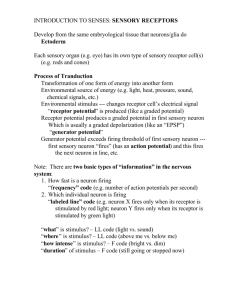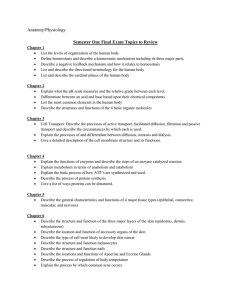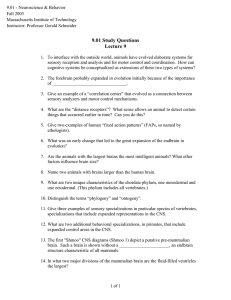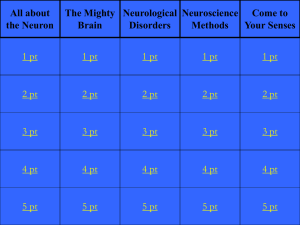Exam III BIOS 118 Anatomy and Physiology Name
advertisement
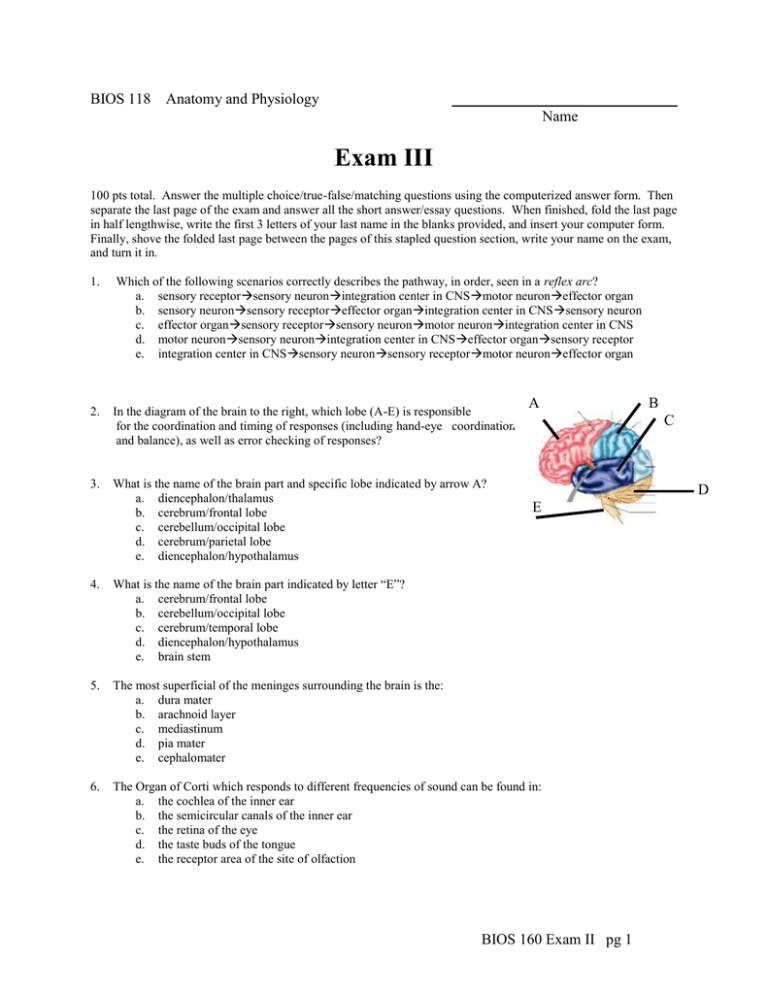
BIOS 118 Anatomy and Physiology Name Exam III 100 pts total. Answer the multiple choice/true-false/matching questions using the computerized answer form. Then separate the last page of the exam and answer all the short answer/essay questions. When finished, fold the last page in half lengthwise, write the first 3 letters of your last name in the blanks provided, and insert your computer form. Finally, shove the folded last page between the pages of this stapled question section, write your name on the exam, and turn it in. 1. Which of the following scenarios correctly describes the pathway, in order, seen in a reflex arc? a. sensory receptorsensory neuronintegration center in CNSmotor neuroneffector organ b. sensory neuronsensory receptoreffector organintegration center in CNSsensory neuron c. effector organsensory receptorsensory neuronmotor neuronintegration center in CNS d. motor neuronsensory neuronintegration center in CNSeffector organsensory receptor e. integration center in CNSsensory neuronsensory receptormotor neuroneffector organ 2. In the diagram of the brain to the right, which lobe (A-E) is responsible for the coordination and timing of responses (including hand-eye coordination and balance), as well as error checking of responses? 3. What is the name of the brain part and specific lobe indicated by arrow A? a. diencephalon/thalamus b. cerebrum/frontal lobe c. cerebellum/occipital lobe d. cerebrum/parietal lobe e. diencephalon/hypothalamus A B C D E 4. What is the name of the brain part indicated by letter “E”? a. cerebrum/frontal lobe b. cerebellum/occipital lobe c. cerebrum/temporal lobe d. diencephalon/hypothalamus e. brain stem 5. The most superficial of the meninges surrounding the brain is the: a. dura mater b. arachnoid layer c. mediastinum d. pia mater e. cephalomater 6. The Organ of Corti which responds to different frequencies of sound can be found in: a. the cochlea of the inner ear b. the semicircular canals of the inner ear c. the retina of the eye d. the taste buds of the tongue e. the receptor area of the site of olfaction BIOS 160 Exam II pg 1 Use the eye diagram at the right to answer the following questions. 7. Which structure is known as the retina? 8. Which structure is known as the choroid layer? 9. Which structure is a transparent and clear part of the sclera? 10. Which structure senses light and produces a nerve impulse? 11. Which space is filled with aqueous humor? 12. Which structure changes shape when muscles pull or relax? 13. Which arrow points to the pupil? 14. Which layer contains the cells called rods and cones? ---------------------------------------------------------------TRUE/FALSE Answer "a" if true and "b" if false. 15. The word "accommodation" in reference to the human eye refers to how well the lens fits within the pupillary gap. 16. Rod cells in the eye are more sensitive to weak light than cone cells. 17. Both hearing and the sense of equilibrium are achieved through the bending of hairs on special cells that can initiate an action potential. 18. The lens of the eye is thinnest when focusing on objects that are far away (see diagram to the right). 19. The function of the incus (anvil), malleus (hammer), and stapes (stirrup) bones are to: a. Support and hold open the pharyngotympanic tube b. Amplify and transmit sound vibrations between the tympanic membrane and oval window c. Support the base of the tongue d. Provide anchoring points for the hypothalamus of the diencephalon e. Protect the delicate olfactory receptors BIOS 160 Exam II pg 2 20. In which structure (in the diagram to the right) are sounds converted into nervous impulses? 21. Which structure is technically called the tympanum? 22. Which structure helps to equalize the pressure between the inner ear and the environment? 23. Which arrow points to the stapes bone? --------------------------------------------------------------------------------------------------------------------------------------- ----Match the hormone on the left with the organ or structure that produces it on the right. If the correct answer is more than one letter, like "abc", fill in "a" AND "b" AND "c" on your answer sheet for that question. 24. Calcitonin; reduces blood calcium levels 25. Epinephrine; increases metabolic rate and blood glucose 26. Insulin; reduces blood glucose 27. Follicle stimulating hormone (FSH); stimulates sperm and ova production 28. Oxytocin; Stimulates uterine contractions and milk "let down" reflex 29. The hormone responsible for stimulating milk production in women. 30. The hormone responsible for releasing glucose sugar into the blood stream from the liver. a. pineal body b. hypothalamus c. anterior pituitary d. posterior pituitary e. thyroid ab. parathyroid ac. thymus ad. adrenals ae. brain bc. pancreas bd. testes be. ovaries cd. stomach ce. small intestine de. kidney 31. The hormone responsible for regulating wakefulness and sleepiness. -----------------------------------------------------------------------------------------------------------------------------------------32. In the steroid hormone mechanism of action, the hormone binds to a receptor and: a. acts to initiate transcription b. stimulates the production of second messenger like cAMP c. causes change only in the cytoplasm of the target cell d. moves through the blood stream to other cells e. causes glucose breakdown within the cell 33. The hypothalamus signals the release of hormones in the anterior pituitary by sending electrical signals through a “wire”. This type of stimulus is known as: a. neural stimulus b. hormonal stimulus c. humoral stimulus d. bipolar diphasic stimulus e. intentional stimulus ------------------------------------------------------------------------------------------------------ -------------------------------------- BIOS 160 Exam II pg 3 True/False Questions. Mark "a" if true and "b" if false. 34. One function of the thyroid gland is to regulate the rate of cellular respiration in most of the body's cells. 35. Glucagon and aldosterone have exactly opposite effects in regulating blood glucose levels. 36. The risk of seeing a huge destruction of red blood cells in a newborn baby is greatest if the mother is Rh positive and the father is Rh negative. ----------------------------------------------------------------------------------------------------------------37. Which of the following lists the steps of hemostasis in the correct chronology, from the first step to the last? a. vascular spasms, coagulation, platelet plug formation b. vascular spasms, platelet plug formation, coagulation c. platelet plug formation, vascular spasms, coagulation d. platelet plug formation, coagulation, vascular spasms e. coagulation, vascular spasms, platelet plug formation 38. After centrifuging a blood sample, several layers appear. What is the name of the topmost layer, as indicated by the question mark in the diagram at the right? a. red blood cells only b. white blood cells only c. white blood cells and platelets d. red blood cells and white blood cells e. plasma only Use the heart diagram at the right to answer the following questions. 39. Which structure blocks the backflow of blood between the aorta and the left ventricle? 40. Which structure contains (in its walls) the pacemaker, or initiator of heart muscle excitation? 41. Which structure is the bicuspid (mitral) valve? 42. If this diagram was in color, which structure would be carrying blue-colored blood away from the heart? -------------------------------------------------------------------------EXTRA CREDIT HEART QUESTIONS ON HEART 43. Which letter(s) point to the heart chamber where blood returns to the heart after visiting the lungs? 44. Which letters point to the vena cava? BIOS 160 Exam II pg 4 ? SHORT ANSWER SHEET BIOS 160 Exam II Name 14 pts. total. Please write your answers in the blanks provided. C. 6 pts. Fill in the blanks with the names of these structures. (the gap) (the extensions coming out) (the whole cell) B. 6 pts. Name the three different chemical types of hormones found in the human body. 1. 2. 3. EXTRA CREDIT QUESTION C. 2 pts. Name or describe the end result of an embolism: BIOS 160 Exam II pg 5 First 3 letters of last name BIOS 160 Exam II pg 6

